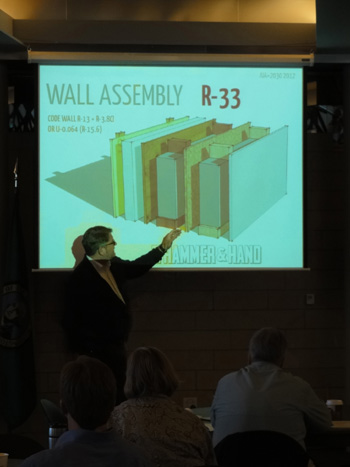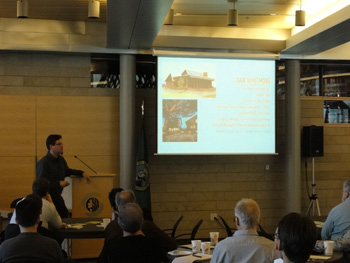Seattle Passive House residence and Portland Passive House commercial retrofit featured.
On a beautiful sunny morning last Friday, a group of 60 architects and engineers gathered at Seattle City Hall to learn about design and construction strategies they can employ to meet the Architecture 2030 Challenge.

The Challenge calls for all new building and major renovations to “be designed to meet a fossil fuel, GHG-emitting, energy consumption performance standard of 60% below the regional (or country) average for that building type.” This goal moves to 70% in 2015, 80% in 2020, 90% in 2025, and to carbon neutral in 2030.
 Friday’s session, entitled “Passively-Aggressive – employing passive systems for load reduction” was part of the AIA+2030 Professional Series 2012 organized by Cassandra Delaune of AIA Seattle and moderated by Tom Marseille of WSP Flack + Kurtz. Hammer & Hand’s Sam Hagerman and Dan Whitmore were joined by session leaders Peter Alspach of ARUP and Rob Pena of UW. The Passive House building standard played a leading role in the proceedings, with Hammer & Hand’s Glasswood passive house commercial retrofit and Dan’s Courtland Place passive house residence taking central stage as case studies of doable high performance construction. (BTW, Dan is our project supervisor for Seattle remodeling and building.)
Friday’s session, entitled “Passively-Aggressive – employing passive systems for load reduction” was part of the AIA+2030 Professional Series 2012 organized by Cassandra Delaune of AIA Seattle and moderated by Tom Marseille of WSP Flack + Kurtz. Hammer & Hand’s Sam Hagerman and Dan Whitmore were joined by session leaders Peter Alspach of ARUP and Rob Pena of UW. The Passive House building standard played a leading role in the proceedings, with Hammer & Hand’s Glasswood passive house commercial retrofit and Dan’s Courtland Place passive house residence taking central stage as case studies of doable high performance construction. (BTW, Dan is our project supervisor for Seattle remodeling and building.)
While the graduated goals of 2030 chart an incremental progression of improvement in energy consumption, the 2030 movement is well beyond the modest incrementalism found in more conventional energy efficiency circles. The 60-100% reductions in fossil fuel consumption for new and renovated buildings sought by 2030 is pretty revolutionary, and recognizes that as an industry we need to dramatically change the way we build. We can’t hope to reach the 2030 Challenge through incremental improvements in building performance alone:
1. We can’t assume a neat, uniform wave of energy efficiency improvements across all of our buildings. Many building owners will improve their structures in the next 18 years, but many won’t. So more dramatic improvements in a portion of the building sector will have to carry the weight of others.
2. An energy retrofit or new construction is often a once-in-a-few-decades opportunity to improvement energy performance. Modest 10% improvements in energy efficiency made today will be insufficient and obsolete in a few years, and totally unequal to the 2030 challenge.
3. And most importantly, incrementalism in energy efficiency is expensive, with the cost of each increment of improvement rising higher and higher with every successive step, until…
…until the point that those efficiency improvements decrease the building’s demand for heat (or cool) so much that the furnace (or A/C) can be replaced with a tiny, hair-dryer sized unit. Then the cost of energy performance improvement plummets, thanks to money saved on now-unnecessary big mechanical systems. This is the point of revolution that Passive House and other truly high performance building inhabits. Cassandra Delaune of AIA Seattle referred to it as “tunneling through the cost barrier”.
“We’re at the hardest point right now, reaching for 60% or 70% reductions,” Cassandra said of the 2030 movement’s current energy efficiency goals. “But once we reach the point where we can tunnel through the cost barrier, I think we’ll move past 80% reductions and right into carbon neutral construction.”
 A paradigm shift is in order: given the (rightly) aggressive goals of Architecture 2030, the movement needs buildings with revolutionary performance. So it’s fitting that AIA+2030 Seattle invited Hammer & Hand to present Passive House case studies.
A paradigm shift is in order: given the (rightly) aggressive goals of Architecture 2030, the movement needs buildings with revolutionary performance. So it’s fitting that AIA+2030 Seattle invited Hammer & Hand to present Passive House case studies.
The Architecture 2030 challenge, and the struggle to evolve our built environment to meet it, reminds me of a famous paradigm shift in evolutionary biology. For over 100 years the traditional school of thought in evolutionary science was gradualism: species adapt slowly and gradually over time. But beginning in the 1970s, Stephen Jay Gould and others turned gradualism on its head and replaced it with the theory of punctuated equilibrium: long periods of relative stasis are shaken up by periods of rapid and sometimes breathtaking evolutionary change.
For our built environment to evolve to a climate-friendly state, it’s becoming clear that we need dramatic, punctuated change in how we build. Gradualism won’t work. Fortunately, 21st century building science, embodied by Passive House and other high performance building standards like the Living Building Challenge, empowers us to realize this revolution.
“With Passive House we have the 100-mpg vehicle of buildings in our pocket right now, ready to go,” Dan said.
– Zack (Connect with me at +ZacharySemke)
P.S. Thank you to AIA+2030 Seattle for inviting Hammer & Hand to share its good high performance building news with our colleagues in the Seattle design community.
Back to Field Notes